MILITARY HISTORY
The 7th Queen’s Own Hussars was a cavalry regiment in the British Army, first formed in 1690. It saw service for three centuries, including the First World War and the Second World War. The regiment was deployed to South Africa in November 1901 and was stationed at Leeuwkop during the Second Boer War.
Private Stenner was a member of the 7th Queen’s Own Hussars Regiment for a period of seven years; the time frame in which he served is unknown.
Sergeant Charles Christopher Stenner — 270 — ACTIVE SERVICE (World War I)
On August 28, 1914, Charles Christopher Stenner completed the Attestation Paper for the Canadian Army, Canadian Expeditionary Force (CEF). He was 36 years, 8 months and 4 days old when, as a married man, he enlisted in Toronto, Ontario for the duration of the War. Charles Christopher was born in London, Middlesex England and gave his birth-date as December 24, 1877. On his Attestation Paper, he indicated “he had never served with a Militia Force” but served with the 7th Queen’s Own Hussars (British) for 7 years. There is nothing in his Records to indicate where he was educated or to what level. As far as employment is concerned, he lists Baker. Charles Christopher had a fair complexion, blue eyes and brown hair; he was 5′ 7½” tall, with a 36” chest (expanded), his weight was given as 138 pounds. His next-of-kin was listed as his wife, Mrs. Florence Stenner of RR #4 Lakefield, Ontario. Charles Christopher’s medical examination was done on August 27, 1914 in Ottawa, Ontario; he was determined fit for the CEF (Overseas). Charles Christopher Stenner signed the Oath and Certificate August 28, 1914, at Toronto and was taken-on-strength to the Princess Patricia’s Canadian Light Infantry (PPCLI) as a Private (Pte) with Regimental Number 270.
Pte Stenner’s Military Records do not have any documentation that covers the period of time from August 29, 1914 to December 20, 1914 with the exception of a note stating “Unit sailed October 3, 1914”. This 3 month, 22 day period would have been used to do Advanced Training, probably in the Valcartier, Québec Training area. The main goal was to form the men into Units and ship them off to England as quickly as possible where their training would be completed. Pte Stenner was drafted Overseas as a member of the 1st Canadian Corps Temporary Base (CCTB) to the PPCLI. He embarked, from Montréal Québec for England aboard the SS Royal George on October 3, 1914. In October 1914 Pte Stenner assigned $25.00 (changed to $15.00 in June 1915) and a Separation Allowance of $20.00, both monthly to his wife Florence.

Pte Stenner would have disembarked at England about October 14, 1914 with his PPCLI Unit. On December 20, 1914 Pte Stenner embarked at Southampton, England attached to the War Office (WO) and disembarked at France. There are no comments in his Military Records to cover the next 15 days, hence it is not known who the PPCLI Unit was taken-on-strength with nor where they were located. January 14, 1915 Pte Stenner was admitted to the No 4 Station Hospital at St. Omer with diarrhea. On February 2, 1915 he had Colitis and went by Convoy (Ambulance Train) to the Base Hospital (unknown location). On February 3, 1915 Pte Stenner was struck-off-strength from the No 4 Station Hospital; transferred by Hospital Train and was admitted, with Diarrhea, to the No 8 General Hospital at Rouen, France and was on Casualty List No 6. On February 24, 1915, still with the No 8 General Hospital, he transfers to England from France with Enteritis (Diarrhea) on authority of the Officer/Commanding (O/C) the PPCLI Unit and was put on Casualty List No 2. On February 25, 1915 he was sick and admitted to the Royal Victoria Hospital (Netley Hospital), near Southampton, England; detached from the WO and put on Casualty List No 2. Pte Stenner had a 7-week history starting with vomiting and diarrhea; he spent 16 days in the hospital.
March 2, 1915 Pte Stenner was transferred from the No 8 General Hospital to the Hospital Train. March 6, 1915 he is transferred to the Hospital Train and put on Casualty List No 2. March 11, 1915 Pte Stenner is awarded a Sick Furlough at W. Hampstead, England by the Royal Victoria Hospital Officer/Commanding to March 25, 1915. March 12, 1915 Pte Stenner is discharged from the Royal Victoria Hospital and March 15, 1915 he is taken-on-strength the Depot at Tidiworth, 5 Sarre St.
April 20, 1915 Pte Stenner appeared before a Medical Board at Shorncliff complaining of vague stomach symptoms; the Board finds that he is fit for Service. April 22, 1915 he is with his Unit at Shorncliffe, England and is on the Muster Parade Roll. June 29, 1915 Pte Stenner had been granted a Sick Furlough from May 26 to June 6, 1915 while at Shorncliffe. July 15, 1915 he saw a doctor with nervousness following dysentery, he was given Light Duty for one month and then return to duty. August 23, 1915 Pte Stenner transfers to the PPCLI at Point Opens, France. September 1, 1915 he joins the PPCLI Battalion (Bn) in the Field.
June 2, 1916 Pte Stenner was wounded, at Ypres, France and taken to the Australian Hospital at Wimereau, France. Pte Stenner was there for 9 days. Examined under X-Rays and Shrapnel found in back. Opened up under local analsthesic. Shrapnel felt but not renoved. Patient admitted here, partialy swol1en and hard, not painful, but patient complains of stiff back. Temperature normal. June 3, 1916 Pte Stenner is admitted to the Australian Hospital at Wimereux in the Field (France) with a Shrapnel Wound in his back. June 13, 1916 he was transferred to the Canadian Casualty Assembly Centre (CCAC) at Folkestone, England and was admitted to Coulter Hospital at 5 Grosvenor Square, England with a slight Shrapnel Wound in his back. June 17, 1916 Pte Stenner underwent surgery to remove shrapnel from his back. Treatment Formentations (the application of hot moist substances to the body to ease pain) four hourly for three days then Eusol dressing once daily – now wash with Iodine. June 23, 1916 Pte Stenner was taken-on-strength from to the CCAC. The CCAC is a centre where wounded were assessed for either further treatment or return to duty.
July 11, 1916 Pte Stenner is admitted to the Canadian Convalescent Hospital (CCH) at Bromley, Kent. July 13, 1916, on authority of the O/C PPCLI, Pte Stenner was discharged to the CCAC from the CCH at Bromley and assigned to 8 weeks of Base Duty. July 14, 1916 he is attached to the RCR/PPCLI Depot at Caesars Camp.
August 12, 1916 he is entitled to wear one Good Conduct Badge, at Shorncliffe. September 1, 1916 a Medical Board was conducted at Caesors Camp, Pte Stenner had a Shrapnel Wound in his back, Wound was in flesh, complains of pain on bending. His disability to be made later (very difficult to read). Board Recommends 4 weeks of physical training at Monks Horton. September 14, 1916 Pte Stenner ceases to be attached to the RCR/PPCLI Depot and is On-Command to the No 1 Canadian Convalescent Depot (CCD) for a 4-week period at Caesors Camp at Monks Horton. On November 17, 1916 the Medical Department, Canadian Command Depot at Shoreham-by-Sea, Sussex did a Medical Board; the finding was that Pte Stenner had recovered and was fit for duty. Then on November 20, 1916 he is discharged from the No 1 CCD and taken-on-strength to the 1st Canadian Casualty Temporary Base (CCTB) at Shoreham, England.
January 1, 1917 Pte Stenner is struck-off-strength from the CCAC to the PPCLI OpSta under the Eastern Ontario Regiment Depot (EORD) at Shoreham. January 5, 1917 Pte Stenner is struck-off-strength from the CCAC on proceeding Overseas with the PPCLI at Hastings, England. On January 6, 1917 Pte Stenner arrived in France and was taken-on-strength of the PPCLI in the Field at the Canadian Base Depot (CBD).
On February 9, 1917 Pte Stenner was struck-off-strength from CBD and left for the 3rd Canadian Ent Battalion (Can Ent Bn) and was taken-on-strength. On February 11, 1917 he arrived at the Can Ent Bn.
On March 5, 1917 Pte Stenner left for his Unit in the Field and arrived on March 6, 1917. On March 24, 1917 Pte Stenner joined the Canadian Corps Reinforcement Camp (CCRC). A centre in France where troops were held before being sent to reinforce existing Units.
About February 20, 2018 Pte Stenner was promoted to the Rank of Lance Corporal (L/Cpl). February 21, 2018 L/Cpl Stenner was posted from the PPCLI, France to the EORD at Seaford, England. February 22, 2018 he is placed On-Command from the EORD to No 1 CDD at Buxton, England. February 23, 1918 L/Cpl Stenner is placed On-Command to No 1 CDD at Buxton pending a Furlough to Canada and is posted to the EORD at Seaford. February 27, 1918 L/Cpl Stenner ceases to be On-Command to No 1 CDD at Bresdor and will be granted a Furlough to Canada for 12 weeks (February 27 to May 22, 1918) at Seaford. Authorization in all cases was amended to read “Pte and not L/Cpl”. Having been retained in Canada he is struck-off-strength of Overseas Military Forces of Canada (OMFC) – The OMFC is a Canadian cabinet ministry that conducted Canadian military affairs in London, England.
L/Cpl Stenner would have embarked at England about March 6, 1918. March 17, 1918 L/Cpl Stenner disembarked at Halifax, Nova Scotia aboard the SS Scandinavian about March 16,1918; he was granted Leave and would be staying at Box 625, Lakefield Ontario; he was taken-on-strength to Military District No 3 at Kingston.
On May 14, 1918 L/Cpl Stenner was admitted with Chronic Bronchitis to the Ongwanada Military Hospital in Kingston, Ontario.
Condition on Admission and Progress of Case
Man comes complaining of a chronic cough with expectoration, he has had this cough one year. He has lost twenty pounds in weight. States that he becomes fatigued on moderate exertion and has dysnnea also on quick movement.
Man is poorly nourished, anemic, pulse is regular and of low tension and easily compressible Lungs.
There are scattered sub-cumitant rales over the bases of both lungs and in the mid auxillary region left side.
First sound is lacking in muscular quality. Apex displaced slightly downward. No valvular lesions.
Treatment Full diet. Tonics, Fe, Et, Quin, Rx.
Condition on Discharge Improved. Returned to District Depot on May 30, 1918.
June 1, 1918 he is transferred to Casualty Company (CC) June 22, 1918 L/Cpl Stenner is struck-off-strength from the CC on transfer to No 3 Aus CTD ??
On October 6, 1918 Sgt Stenner was admitted with Influenza to the Ongwanada Military Hospital in Kingston, Ontario.
Condition on Admission and Progress of Case
On admission patient complained of headache, pains in shoulders, pain in eyes, slight cough, very little expectoration. High temperature and rapid pulse. Bronchitis troublesome.
October 8, 1918 – Patient nauseated. Cough is very troublesome.
October 10, 1918 – Temperature normal and patient feels slightly better.
October 14, 1918 – Evidences of patches of Broncho Pneumonia on right side at base and middle lobe.
October 16, 1918 – Slight extension of Broncho Pneumonia. T.100 at 1 a.m. T. 103.8 at 9 a.m.
October 17, 1918 – Slight lowering of Temperature and fall by lysis extending over next three days.
October 21, 1918 – Temperature sub-normal. Patient very weak and nauseated, coughing freely.
November 4, 1918 – Up for a short time to-day, very weak.
November 28, 1918 – Patient discharged to Unit, with recommendation for convalescent leave.
Treatment Routine prescribed treatments for Influenza. Stimulation of during last stage of Broncho Pneumonia. Special Nourishment.
Condition on Discharge Discharged to Unit, on November 28, 1918, with recommendation for convalescent rest and leave.
May 22, 1919 Sgt Stenner is transferred and taken-on-strength of the Queen’s University Military Hospital (QUMH) at Kingston.
Medical History from the September 11, 1919:
Enlisted in August 1914. Went to France in December 1914. Wounded, flesh wound in back – lumbar region – June 2, 1916. Sent to England and where wounds healed leaving no disability. Returned to France January 1917. He began to be bothered with Bronchitis in September 1917 but did not have to leave Lines. Returned to Canada in February 1917. He had a severe attack of Influenza followed by Pneumonia in November 1918. After recovering from this he noticed that hearing in his left ear was defective.
September 15, 1919 Sgt Stenner is struck-off-strength from the QUMH on demobilization, as medically unfit for General Service. September 15, 1919 Statement: Sergeant Charles Christopher Stenner was struck-off-strength from the Canadian Army (Active) upon being discharged and was paid in full up to September 15, 1919.
Sergeant Charles Christopher Stenner served with the Canadian Army a total of 5 years, and 18 days: 1 year, 7 months and 9 days in Canada; 1 year, 2 months, 21 days in the UK; 2 years, 1 months and 23 days in France and 24 days travel time.
Based on his Military Service, Sergeant Charles Christopher Stenner would have been awarded the:
1914 – 15 Star
British War Medal; and
Victory Medal.
He was also awarded War Service Badge – CEF Class “B”
An excerpt from an article in Maclean’s magazine by Barbara Ameil, September 1996:
The Military is the single calling in the world with job specifications that include a commitment to die for your Nation. What could be more honorable?
PERSONAL HISTORY
CHARLES CHRISTOPHER STENNER
Charles Christopher Stenner was born December 24, 1877 in Westminster, London, Middlesex, England. He was the son of Aldred John Stenner and Sarah Barringer of England. He married Florence Hills, daughter of Thomas Hills and Mary Wells in Mark’s Church, Epping Essex, England on May 25, 1904. Charles emigrated to Canada in 1906 and his wife and first born son Percival “Percy” Douglas arrived in 1907. They settled near Warsaw, Ontario around 1907 and Charles was working as a farm labourer. Charles enlisted to serve his King and country in WWI in August 1914.
By 1916 the family had moved to Lakefield and were living on Ermatinger Street. They had a family of six children Percival Douglas, Thomas Aldred, Roger, George Gileod, Robert Michael and Ellen Stenner. After his discharge on September 15, 1919, Charles returned to his family in Lakefield and worked as the caretaker of the Lakefield public and high school for several years. He was also caretaker of St. John the Baptist Anglican Church, of which he was a faithful member. Charles took an active part in the Canadian Legion Branch #77 at Lakefield, being President once. For fifteen years, he was in charge of every military parade the village has had including being in charge of the guards of honour at the dedication of the Lakefield cenotaph. Charles was also an ardent curler and a member of the Lakefield Curling Club. Charles passed away on July 29, 1940 and Florence died on July 19, 1963; both are buried in Hillside Cemetery in Lakefield.
The 1911 Census indicates that the family was living in Douro – Charles was working as a farm labourer & Charles immigrated to Canada in 1906 and wife Florence in1907.
THE CHARLES CHRISTOPHER STENNER FAMILY DOURO TOWNSHIP
The paternal grandparents of Charles Christopher Stenner were Aldred John Stenner and Sarah Barringer of Somerset, England. Aldred worked as a butler. His maternal grandparents were Thomas Hills and Mary Wells of Middlesex, England.
CHARLES CHRISTOPHER STENNER – DECEMBER 24, 1877 – JULY 29, 1940
The death at Lakefield of Charles Stenner, Veteran of the last Great War and prominent in the activities of the Canadian Legion, will remind old-timers of one of the greatest exhibitions of gameness in the history of local sport. The story goes back well over thirty years ago, to the first six-day walking match held in Brock Street Rink, when W. A. Hoagland of Auburn, N.Y., astonished the whole district by walking faster over a long period than anyone around here believed it possible for a human being to walk. Charlie Stenner, a young Englishman who had seen service in South Africa with the 7th Hussars, was working near Warsaw at the time and decided to enter the race.
The ex-cavalryman soon found that he was up against champion pedestrians. Hoagland, Blake and other American cracks set a pace on the first night that ordinary walkers found it impossible to cope with, and contestant like Stenner soon dropped far behind. Most of them gave up the attempt early, but not the young man from Warsaw. Miles behind, losing on every lap, he plodded along mile after mile. By the second night his feet were badly blistered and by Wednesday they were like a piece of raw beefsteak, but Stenner doggedly kept on. Newspapermen, admiring his sheer courage, saw to it that the Warsaw walker got a good meal after each night’s performance, and that his feet were treated. They tried to persuade him to quit, but the Britisher stoutly refused, although every step was an effort and he hadn’t the slightest chance of coming anywhere near the prize winners. The word quit was not in his book and he finished.
He was one of the first from this district to enlist for service in August 1914 and went overseas to fight for Canada as a member of the famous Princess Pats. Those who had seen the gameness he showed in those nights back in Brock Street Rink had no doubt that he would fight gamely in the big game overseas. And he did. References to his qualities have been made elsewhere. This is merely a tribute from an eye-witness of something that has always ranked in the memory of one durance any local sporting event has ever produced.
(Article typed from Mayme Grills Scrapbook – 1940’s – page 27)
CHARLES STENNER DIES AT LAKEFIELD CLOSING LONG MILITARY CAREER
A widely known Veteran of the First Great War, Charles Christopher Stenner died on Wednesday at his home in Lakefield. Mr. Stenner, 62 years of age, had been ill for the past 8 months and word of his gradually declining health was received by returned soldiers with deep concern and regret. His death yesterday did not come as a surprise, but it left hundreds of his comrades in sorrow in this district.
A distinguished military career was closed with the death of Mr. Stenner. He was a member of the original Princess Pats Canadian Light Infantry and saw a great deal of active service in the First Great War as well as in the South African War. On his return to Canada after the close of the War, Mr. Stenner took an active part in the Canadian Legion Branch #77 at Lakefield, being President once. During the past 15 years he has been in charge of every military parade the village has had.
Charlie Stenner was born in England, son of the late Aldred John Stenner and Sarah Barringer. He came to this country 34 years ago and moved to Warsaw. Ten years later he moved to Lakefield and lived there until his death yesterday, except for the years he spent overseas.
He was caretaker of the Public and High School of Lakefield for the past several years and was formerly caretaker of St. John the Baptist Anglican Church, of which he was a faithful member. He was also an ardent curler and a member of the Lakefield Curling Club.
Surviving beside his sorrowing wife are four sons, Percy of Young’s Point, Roger and George of Lakefield and Robert of the 4th Anti-Tank Battery, C.A.S.F.; one daughter Ellen at home; two sisters Maud of Toronto and Mrs. Baldwin of England, and two brothers William of Toronto and Alfred of England.
The funeral will take place on Friday afternoon at 2:30 o’clock day light time, the service in St. John the Baptist Anglican Church, Rev. H. R. Howden officiating. Interment will be in Hillside Cemetery.
(Article typed from Mayme Grills Scrapbook – 1940’s – page 97)
Charles Stenner Dies At Lakefield Closing Long Military Career – Peterborough
Examiner Published August 1940
A widely known Veteran of the First Great War, Charles Christopher Stenner, died on Wednesday at his home in Lakefield. Mr. Stenner, 62 years of age, had been ill for the past 8 months, and word of his gradually declining health was received by returned soldiers with deep concern and regret. His death yesterday did not come as a surprise, but it left hundreds of his comrades in sorrow in this district.
A distinguished military career was closed with the death of Mr. Stenner. He was a member of the original Princess Pats Canadian Light Infantry and saw a great deal of active service in the First Great War as well as in the South African War. On his return to Canada after the close of the war, Mr. Stenner took an active part in the Canadian Legion Branch at Lakefield, being its president once. During the past 15 years he has been in charge of every military parade the village has had.
Lakefield 24 Years
Charlie Stenner was born in England, son of the late Aldred John Stenner and Sarah Barringer. He came to this country 34 years ago, and moved to Warsaw. Ten years later he moved to Lakefield and lived there until his death yesterday, except for the years he spent overseas. He was caretaker of the Public and High School of Lakefield for the past several years, and was formerly caretaker of St. John’s Anglican Church, of which he was a faithful member. He was also an ardent curler and a member of the Lakefield Curling Club.
Surviving besides his sorrowing wife, are four sons, Percy of Youngs Point, Roger and George of Lakefield and Robert of the 4th Anti-Tank Battery, C.A.S.F.; one daughter, Ellen at home; two sisters, Maud of Toronto and Mrs. Baldwin of England, and two brothers, William of Toronto and Alfred of England. The funeral will take place on Friday afternoon at 2:30 o’clock day light time, the service in St. John’s Anglican Church, Rev. H. R. Howden officiating. Interment will be in Hillside Cemetery.


